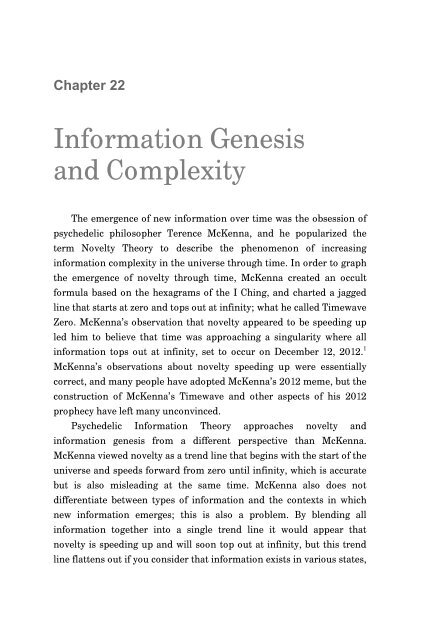Psychedelic-information-theory-Shamanism-in-the-age-of-Reason
Psychedelic-information-theory-Shamanism-in-the-age-of-Reason
Psychedelic-information-theory-Shamanism-in-the-age-of-Reason
- No tags were found...
Create successful ePaper yourself
Turn your PDF publications into a flip-book with our unique Google optimized e-Paper software.
Chapter 22Information Genesisand ComplexityThe emergence <strong>of</strong> new <strong><strong>in</strong>formation</strong> over time was <strong>the</strong> obsession <strong>of</strong>psychedelic philosopher Terence McKenna, and he popularized <strong>the</strong>term Novelty Theory to describe <strong>the</strong> phenomenon <strong>of</strong> <strong>in</strong>creas<strong>in</strong>g<strong><strong>in</strong>formation</strong> complexity <strong>in</strong> <strong>the</strong> universe through time. In order to graph<strong>the</strong> emergence <strong>of</strong> novelty through time, McKenna created an occultformula based on <strong>the</strong> hexagrams <strong>of</strong> <strong>the</strong> I Ch<strong>in</strong>g, and charted a jaggedl<strong>in</strong>e that starts at zero and tops out at <strong>in</strong>f<strong>in</strong>ity; what he called TimewaveZero. McKenna’s observation that novelty appeared to be speed<strong>in</strong>g upled him to believe that time was approach<strong>in</strong>g a s<strong>in</strong>gularity where all<strong><strong>in</strong>formation</strong> tops out at <strong>in</strong>f<strong>in</strong>ity, set to occur on December 12, 2012. 1McKenna’s observations about novelty speed<strong>in</strong>g up were essentiallycorrect, and many people have adopted McKenna’s 2012 meme, but <strong>the</strong>construction <strong>of</strong> McKenna’s Timewave and o<strong>the</strong>r aspects <strong>of</strong> his 2012prophecy have left many unconv<strong>in</strong>ced.<strong>Psychedelic</strong> Information Theory approaches novelty and<strong><strong>in</strong>formation</strong> genesis from a different perspective than McKenna.McKenna viewed novelty as a trend l<strong>in</strong>e that beg<strong>in</strong>s with <strong>the</strong> start <strong>of</strong> <strong>the</strong>universe and speeds forward from zero until <strong>in</strong>f<strong>in</strong>ity, which is accuratebut is also mislead<strong>in</strong>g at <strong>the</strong> same time. McKenna also does notdifferentiate between types <strong>of</strong> <strong><strong>in</strong>formation</strong> and <strong>the</strong> contexts <strong>in</strong> whichnew <strong><strong>in</strong>formation</strong> emerges; this is also a problem. By blend<strong>in</strong>g all<strong><strong>in</strong>formation</strong> toge<strong>the</strong>r <strong>in</strong>to a s<strong>in</strong>gle trend l<strong>in</strong>e it would appear thatnovelty is speed<strong>in</strong>g up and will soon top out at <strong>in</strong>f<strong>in</strong>ity, but this trendl<strong>in</strong>e flattens out if you consider that <strong><strong>in</strong>formation</strong> exists <strong>in</strong> various states,


